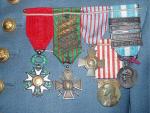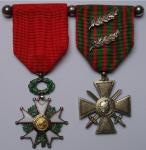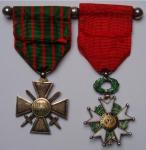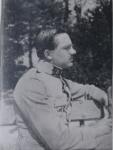-
Posts
402 -
Joined
-
Last visited
-
Days Won
2
Content Type
Profiles
Forums
Blogs
Gallery
Events
Store
Everything posted by Bison
-
Yes it is one of the most common medals we can find in France (for now). But note it is one of the most unfamiliar, even for the French. It has been largely disseminated between 1936 and 1963. A lot of manufacturers got it. Therefore, there are a lot of different models. For example, the official model (officer) is like this... look at the differences with the models above. The obvious one are the buttons, not present on the regular model, but there are many others: http://gmic.co.uk/uploads/monthly_11_2008/post-2068-1226426479.jpghttp://gmic.co.uk/uploads/monthly_11_2008/post-2068-1226426494.jpg Cheers Bison
-
-
Good evening ccj Normally, only the full size groups are worn on uniform. But we know that there were many attempts to this rule when we read the reminders, routine letters and memos calling back to comply with it after the war. And you must know that not complying with the dress rules is a sort of sport in the French Army. Then this group is prepared to be worn on uniform... in spite of the rule, and because it is more elegant... An other assumption is that it is a group of a woman (a nurse? an ambulance driver?)... I do not know. I found it in Belgium... Regards Bison
-
-
Yes it is! Thanks a lot.
-
A friend of mine get this medal : http://gmic.co.uk/uploads/monthly_11_2008/post-2068-1226001349.jpghttp://gmic.co.uk/uploads/monthly_11_2008/post-2068-1226001331.jpg Could you give any information about it? I assume it is a pre-soviet period medal... but that's all. Thank you in advance. Regards Bison
-
Here is a little group of a L?gion d'honneur (chevalier) and a Croix de guerre 1914-1915 with two palms. The Croix de guerre is silver gilt. They are half size, 2,5cm. I like this kind of group. http://gmic.co.uk/uploads/monthly_11_2008/post-2068-1225988113.jpghttp://gmic.co.uk/uploads/monthly_11_2008/post-2068-1225988199.jpg Cheers Bison
-
Nevertheless, the 110? R?giment d'Infanterie, which badge is shown in the last post is part of the French-German Brigade, with the 292. J?gerbataillon. Both are in Donaueschingen. Regards
-
Hello Michael Here is a picture of my grandfather, in uniform of the 3? G?nie. He was a second lieutenant at this time. Regards
-
The two red ribbons stand for the Ordre de Saint Louis and the L?gion d'honneur. The Ordre de Saint Louis was reestablished after 1815 and suppressed in 1830. Therefore, this fine portrait could be from this period... just after the 1st Empire.
-
Hello Garth Thank you for sharing ! Your Ouissam Alaouite is not a Chevalier but an Officier. The rosette on the ribbon is missing. The Chevalier has no foliage around the star and is full silver. Like this (first type) : And an officer (second type) : Regards Bison
-
Thanks Michael ! PM is ongoing.
-
Hello Michael My grand father was aspirant, second and first lieutenant in the 3? G?nie. Ha spent the four years of war in the front, miraculously without to be wounded. He was in the 6? G?nie at the very beginning of the war, then in the 3?, and in 1917 instructor detached to the US troops. Unfortunately, I do not know in which coy he was. My mother had his military papers and I'll have a look next time I go to her. My other grandfather was corporal in the 8? G?nie, and he was severely wounded in Verdun on the 27 March 1916. He was let dead, and drawn back in a mass grave in which he suddenly awaked and crawled away... He was mentioned and received the Croix de Guerre for that. He went back to the front and was responsible for the pigeons messagers and signals. He was mentioned a second time for having crossing the lines to place a telephone wire, and arrived with one bullet in the rollbox... Then, he get the M?daille Militaire in 1918. But he was enlisted with a wrong name in his military ID and was demobilized. Then, eventually obtained this medal awarded in the 50's when the authorities succeed to find him... knowing only his town (in Algeria!) and its christian name. Two (three, four?) miracles for the unprobable result I am writting to you this evening... and able to show their souvenirs cautiously kept by the family. Regards Bison
-
And this one, probably made by Arthus Bertrand. Note that the medal = 1 wound, and each little additional red star a wound more. Therefore, this one with three stars means four wounds.
-
Hello This subject about the French Wound insignia is very interesting. I would like to mention the best study made about it : "Les Insignes des bless?s de la Premi?re guerre mondiale ? nos jours" written by Christophe de Sola and Jean Hass. In the years 1924 - 1925, the veterans were not satisfied with the wound insignia as described above; Then, they created a non official medal, which was progressively tolerated. Nowadays, this unofficial medal is accepted to be worn by the wounded. There is currently a project in France to create a new -and official - medal. Here are two different models (there are many others):
-
Hello Kim, The 'Bataillon de Cor?e' was created in 1950. Then it was sent in Corea within the 2nd US Inf DIV, 23rd Rgt. 3421 French soldiers participated to the Corean war, 287 were killed in action. Then, it was sent in Indochina from 1953 to 1954. Immediatly after it was commited in Algeria from 1955 to 1962. In 1960 it became the 156th R?giment d'Infanterie. It has been disbanded in 1962. Note that Major Jules Jean-Louis, doctor in the battalion, KIA during the battle of Jang Nam Ri, has a statue in South Corea because he rescued a lot of Corean soldiers. Therefore, this unit existed during 12 years and we can assume that a lot of insignias were manufactured. You have a great job in front of you to find the owner corresponding to the number engraved. Regards Bison
-
As far as I collect French medals and orders, I may have some interests in FFL...
-
... or find a souvenir ensemble: these are my two grand fathers: ...which identified the owner. This kind of frame was current in the 30's, but nowadays more and more scarce...
-
The topic of the WWI croix de guerre is very large. Basically, one can find a lot of this cross which have been largely but legitimately awarded. In a collection, the challenge is to gather all the years of WWI, more than palms or stars (note the different ribbons variation of colors) : ...and sizes: ...and coquetries: ...and eventually find a group, identified: ...or with the mention: All that parameters could boost the price of this apparently common cross Yours
-
I can add that this badge was regularly worn on the beret. Here is Colonel Monclar, commanding officer of the Battalion. I know that here has been a lot of badges manufactured by different companies like Drago or Arthus-Bertrand. Yours is wearing the number 312. It could be a badge of a Veteran. That's all I know. May be a specialist would be kind enough to go deeper into details?















